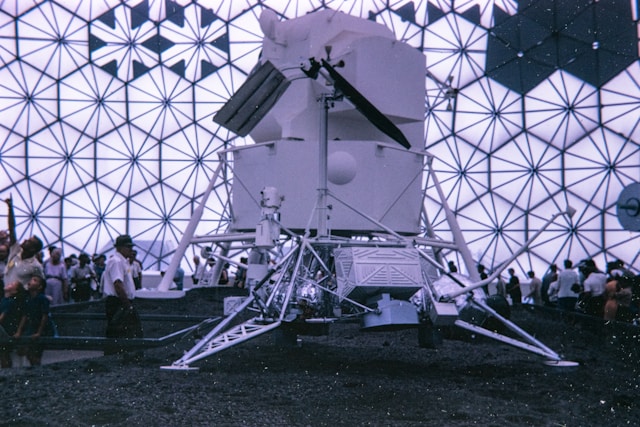Facts About Danbury Mission Technologies You Probably Didn’t Know
What Is Danbury Mission Technologies? (Let’s Break It Down)
Let’s bust a myth immediately—Danbury Mission Technologies isn’t just another tech contractor making random parts for satellites. Many people think it’s just some quiet defense supplier tucked away in Connecticut, doing top-secret stuff with no real-world impact. But that’s far from the truth.
Danbury Mission Technologies is a powerhouse in aerospace and defense innovation, especially known for its precision optical systems, satellite imaging tech, and electro-optical (EO) payloads. They create the “eyes” of satellites—the kind that help governments see what’s happening in space, on land, and sometimes even through clouds.
You’ve probably heard terms like EO/IR sensors or ISR technologies tossed around in the world of military and space talk. Well, Danbury is right at the heart of that. Their tech is used for intelligence, surveillance, and reconnaissance (ISR), and plays a big role in geospatial data collection and remote sensing—super important when it comes to national defense and space observation.
And it’s not just about defense. They also serve NASA, commercial space companies, and other agencies that need high-res satellite sensors or mission-specific payloads that don’t mess around when it comes to accuracy.
So yeah, Danbury Mission Technologies isn’t your average contractor. Think of them as the silent visionaries behind some of the world’s most advanced satellite and surveillance tech.
A Quick Look Into the History of Danbury Mission Technologies
Now, let’s rewind a bit. Every great tech giant has a story, and Danbury is no different.
It all started with a rich legacy in precision optics manufacturing. Danbury’s roots trace back to when aerospace innovation was just taking off in the U.S., and Connecticut was quietly becoming a hub for advanced engineering. Over the decades, they’ve evolved from a niche optics shop to a full-blown leader in space-based sensor platforms.
Back in the day, their engineers helped develop high-performance sensors for everything from defense satellites to NASA missions. Fast forward to now—they’ve been behind major EO/IR technology breakthroughs that drive modern surveillance satellites and national security optics.
Through ownership transitions and new partnerships, Danbury Mission Technologies continued to grow, staying true to one goal: building mission-critical technologies that work when it matters.
Even though they’re not a household name, their impact on U.S. military imaging, deep space exploration, and aerospace optics is massive. From ground-to-space communications to custom-built optical payloads, they’ve played a key role in shaping how we see the world, from above.
Who Owns Danbury Mission Technologies Today?
Let’s clear up a common misconception first—Danbury Mission Technologies isn’t some mysterious government-owned entity working out of a classified bunker. A lot of folks assume it’s 100% federal, but that’s not quite the case.
Danbury Mission Technologies is part of a larger private-sector tech ecosystem. Over the years, it has been under the wing of different corporations, each helping it grow stronger in the defense and aerospace game. While it works closely with U.S. government agencies, it’s not owned by them.
Today, Danbury operates with the flexibility of a private company while still developing mission-critical technologies for national defense, intelligence operations, and space missions. This mix of private ownership and public sector collaboration allows them to stay innovative, fast-moving, and highly secure.
So if you were wondering “who owns Danbury Mission Technologies?”, the answer is—it’s privately held, but its heart beats in sync with U.S. defense and aerospace priorities. That balance is what makes it such a trusted partner in building tech for the skies and beyond.
Inside the Tech: What Makes Their Space Systems So Special?
Now let’s dive into the fun stuff—the tech itself. Because hey, anyone can say they build cool things for space. But Danbury? They walk the talk.
Forget the idea that all space systems are created equal. They’re not. Danbury Mission Technologies stands out because it focuses on precision, reliability, and advanced optical payloads that perform under the toughest conditions.
One of the biggest things they’re known for? Electro-optical (EO) and infrared (IR) sensor systems. These are the high-powered “eyes” used in military satellites, earth observation, and space-based surveillance. And they’re not off-the-shelf tech. These systems are custom-designed, mission-specific, and often built to handle things like thermal distortion, radiation in space, and low-light environments.
Danbury’s space systems are also optimized for geospatial data collection, satellite imaging, and remote sensing. This tech plays a huge role in everything from disaster monitoring to border security. And when it comes to defense satellites? Their gear helps operators see farther, clearer, and faster, giving a critical edge in high-stakes situations.
You’ll also hear a lot about their precision optics, which are used in both commercial space payloads and national security missions. These optics allow satellites to zoom in on targets with detail—think high-res satellite sensors with pin-sharp clarity.
So yeah, when we say “Danbury Mission Technologies space systems explained,” we’re talking about a lineup of tools that help shape how we understand and protect our world, whether it’s orbiting 400 miles above Earth or helping out on the ground via secure data links.
How Danbury Mission Technologies Supports National Defense
Let’s kick off by busting a big myth—Danbury Mission Technologies isn’t just building tech for space exploration. A lot of folks think their focus is purely on satellites for scientific research or environmental monitoring. But in reality, they play a huge role in U.S. national defense.
Danbury is right in the thick of it when it comes to developing technology that helps keep the country safe. Their systems are critical to military satellites, ISR (intelligence, surveillance, and reconnaissance) missions, and even real-time threat detection. Whether it’s tracking movement on the ground, gathering high-res data from orbit, or detecting unusual patterns from thousands of miles away, Danbury’s tools help decision-makers act fast and smart.
One of their major contributions lies in secure space communications and classified optical systems used for defense intelligence gathering. These aren’t just regular sensors—they’re built for stealth, precision, and reliability in high-risk environments. And because of that, defense agencies and military contractors trust Danbury to deliver when the stakes are high.
From electro-optical payloads to next-gen space sensors, Danbury’s systems are embedded in many of the satellite platforms currently protecting national interests. Their tech helps with border surveillance, strategic reconnaissance, missile detection, and even battlefield coordination—all through real-time satellite imaging and ISR data collection.
Bottom line? If you’re asking how Danbury Mission Technologies supports defense, the answer is: quietly, effectively, and with mission-critical impact.
Danbury’s Optical Payloads: A Game-Changer in Space
Here’s a misconception we need to toss aside—optical payloads are not all the same. Some companies use basic imaging systems that can snap a few decent pictures from orbit. But Danbury? They design next-level optical payloads that can see more, clearer, and smarter than most in the industry.
So, what makes Danbury Mission Technologies’ optical payloads stand out?
For starters, they’ve mastered the science of advanced EO/IR sensor fusion. That means combining electro-optical and infrared tech to create imaging systems that work day or night, through weather, smoke, and even camouflage. Their precision space hardware is built for clarity and consistency, no matter the conditions in orbit.
These payloads are often tailored for specific mission requirements—whether that’s for national security, deep space observation, or earth mapping. And unlike off-the-shelf solutions, Danbury’s setups are engineered to integrate seamlessly with different satellite platforms, offering plug-and-play flexibility with top-tier performance.
They’re also leaders in miniaturized optics, allowing for lighter, more compact payloads that don’t sacrifice image quality. This is a big deal in aerospace, where every gram counts. And when it comes to high-resolution satellite imaging, Danbury’s optics offer some of the sharpest eyes in space.
If you’re looking at the future of precision satellite technology, you’ve got to look at Danbury. Their optical payloads are a game-changer, helping everyone from defense agencies to scientific researchers unlock new layers of vision from above.
Is Danbury Mission Technologies a Government Contractor? Here’s the Truth
Let’s clear up a big misunderstanding first—Danbury Mission Technologies isn’t a full-fledged government agency. Some people hear “mission technologies” and instantly assume it’s just a government-run operation with no private involvement. But that’s not the case at all.
Yes, Danbury works very closely with government agencies, but it’s still a private company at its core. Think of it like this—it’s a trusted partner that delivers advanced aerospace and defense tech for U.S. government contracts, especially in the intelligence and surveillance sectors. But it’s not directly part of any federal department.
Danbury is what you’d call a prime contractor or a key subcontractor, depending on the project. It often works under contracts from agencies like the Department of Defense (DoD) or NASA, handling classified payloads, mission-critical optics, or high-resolution space sensors. And since these missions are usually top priority, Danbury’s role is anything but minor.
So, if you’re wondering, “Is Danbury Mission Technologies a government contractor?”, the answer is: Yes, but not exclusively. They are privately owned and operate with the speed and flexibility of a tech company, while still building solutions that power some of the government’s most sensitive and essential space missions.
Recent Developments: What’s Danbury Up to Now?
Now let’s bust another myth—Danbury isn’t stuck in the past or riding on its old achievements. Quite the opposite. This company is actively evolving, taking bold steps in next-gen aerospace solutions and space-based defense systems.
In recent years, Danbury Mission Technologies has been heavily involved in developing new optical payloads for low Earth orbit (LEO) satellites, enhancing geospatial intelligence platforms, and pushing the boundaries of real-time surveillance tech. Their systems are becoming more compact, more powerful, and more integrated with AI-based image processing—yes, they’re that advanced.
They’re also playing a bigger role in space-based defense innovations, especially in response to modern threats. From hypersonic missile tracking to persistent Earth observation, Danbury is stepping up with solutions that can provide fast, secure, and accurate intelligence in dynamic environments.
You’ll also find them collaborating with other leaders in the space industry, forming alliances to develop modular satellite payloads, multi-mission optical systems, and next-gen satellite constellations. Their latest work is all about building scalable tech that can serve both government and commercial customers.
So, what is Danbury Mission Technologies doing now? In simple terms: they’re helping shape the future of space defense and satellite intelligence, staying ahead of both competition and the curve.
Danbury Mission Technologies Careers: Why It’s a Dream Job for Tech Enthusiasts
Let’s clear the air on a common myth first—working at Danbury Mission Technologies isn’t just for rocket scientists. A lot of people think you need a Ph.D. in astrophysics or decades of defense experience to even get a foot in the door. That’s not true at all.
In reality, Danbury Mission Technologies careers are super diverse. Sure, they do hire top minds in aerospace engineering, optical science, and defense technology. But they also need folks in project management, software development, systems integration, cybersecurity, and even business development. Whether you’re a tech geek, a problem solver, or someone who loves mission-driven work, there’s a role for you.
And the cool part? Danbury offers an exciting work environment. You’re not just coding or analyzing spreadsheets—you’re contributing to missions that matter. You could be part of a team building a space-based surveillance system or working on classified payloads for national defense. That’s not your average 9 to 5.
They also provide competitive salaries, growth opportunities, and access to cutting-edge tech. Plus, since they’re deeply connected to both government contracts and private aerospace innovation, your work always feels meaningful. It’s not just a job—it’s a mission.
So if you’re wondering, “Is Danbury Mission Technologies hiring?” or “What’s it like working there?”, the answer is simple: it’s one of the best places to launch a future-focused tech career.
Who Owns Danbury Mission Technologies? A Quick Look Behind the Curtain
Here’s a quick myth to debunk—Danbury Mission Technologies is not some mysterious black-ops branch of the U.S. military. Some folks imagine it’s owned directly by the government, running secret missions from underground bunkers. Nope. Not even close.
Danbury Mission Technologies is actually a division of the larger defense and aerospace company called AMERGINT Technologies Holdings. It became part of AMERGINT in recent years, after Raytheon Technologies spun off the division. That move allowed Danbury to get more focused, agile, and tech-driven.
So if you’re asking, “Who owns Danbury Mission Technologies?”, the answer is: AMERGINT Technologies Holdings—a trusted name in secure communications, satellite tech, and national defense support.
This partnership has helped Danbury level up. With AMERGINT’s backing, Danbury has more access to investment, innovation, and strategic collaboration. It also allows them to push ahead in areas like optical payload development, space-based ISR systems, and real-time satellite imaging solutions.
Even though they operate on a mission-critical level, Danbury is still part of the private defense tech ecosystem, not a government entity. So if you’re diving into research about ownership of Danbury Mission Technologies, now you know—it’s a powerhouse under AMERGINT, and together, they’re pushing the future of space tech forward.
✅ Key Partnerships and Collaborations
- Break the myth: Danbury isn’t working alone in the dark.
- Highlight key collaborations with organizations like NASA, U.S. Air Force, Lockheed Martin, and commercial satellite firms.
- Discuss strategic partnerships for space-based defense, optical intelligence systems, and classified payload innovation.
- Naturally use LSI keywords like:
Danbury and Lockheed Martin,Danbury Mission Technologies partnerships,collaborations in aerospace and defense.
✅ Final Thoughts: Why Danbury Mission Technologies Is Worth Watching
- Dispel the belief that only big names like SpaceX or Raytheon dominate this space.
- Recap why Danbury Mission Technologies deserves attention in 2025 and beyond.
- Emphasize their aerospace innovation, mission-focused culture, defense tech leadership, and growth potential.
- Include keyword phrases like:
why Danbury Mission Technologies matters,future of aerospace defense companies,emerging players in satellite tech.
🔚 Final Words: Wrapping It All Up
At first glance, Danbury Mission Technologies might seem like just another defense tech company, but it’s much more than that. From cutting-edge optical systems to high-stakes government collaborations, they’re helping shape the future of national security and space innovation.
Whether you’re here to learn about their career opportunities, explore their government contracts, or dig into their advanced aerospace technologies, one thing’s clear—Danbury isn’t standing still. They’re evolving fast, building smarter systems, and teaming up with the biggest players in the game.
So, if you’re searching for a name that quietly powers big missions, keep Danbury on your radar. Trust us, this is one company that’s not just aiming high—they’re already orbiting the future.







